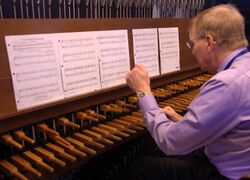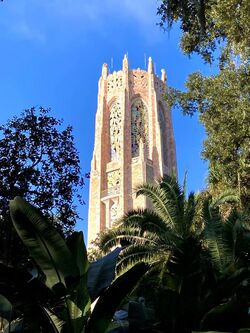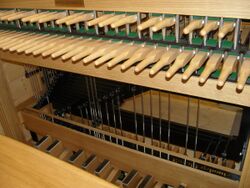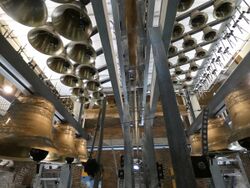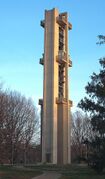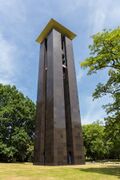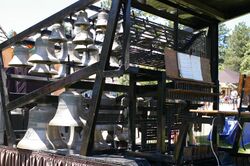Biology:Carillon
A carillon (US: /ˈkærəlɒn/ CARE-ə-lon or UK: /kəˈrɪljən/ kə-RILL-yən;[1] French: [kaʁijɔ̃]) is a pitched percussion idiophone that is played with a keyboard and consists of at least 23 cast bronze bells in fixed suspension and tuned in chromatic order so that they can be sounded harmoniously together. Usually housed in a bell tower and owned by churches, universities, or municipalities, the bells are struck with clappers, which are connected to a keyboard of wooden batons played with the hands and pedals played with the feet. Often, carillons include an automatic system through which the time is announced and simple tunes are played throughout the day.
Carillons come in a wide variety of appearances, weights, sizes, and sounds. One of the world's heaviest instruments, the heaviest carillon weighs over 91 metric tons (100 short tons). Most carillons weigh between 4.5 and 15 metric tons (5.0 and 16.5 short tons). To be considered a carillon, a minimum of 23 bells are needed, otherwise it is called a chime. Standard-sized instruments have about 50, and the world's largest has 77 bells. The appearance of a carillon is dependent on the number and weight of the bells and the tower in which it is housed. They may be found in towers which are free-standing or connected to a building. The bells of the carillon may be directly exposed to the elements or hidden away inside the structure of their tower.
The origins of the carillon can be traced back to the Low Countries—Belgium, the Netherlands, and the French Netherlands—in the 16th century. The modern carillon is considered to have been invented in 1644 when Jacob van Eyck and the Hemony brothers cast the first tuned carillon. The instrument experienced a peak in the mid-18th century and a revival following the destruction of many carillons during the First and Second World Wars.
There are two main types of carillons: traditional and non-traditional. Traditional carillons are those which are played manually with a baton keyboard and do not operate with electronic or computerized action. There are approximately 700 traditional carillons and almost 500 non-traditional carillons worldwide. The majority are concentrated around its place of origin, though nearly 200 have been constructed in North America. Almost all extant carillons were constructed in the last century. A few "traveling" or "mobile" carillons are fixed to a frame that enable them to be transported.
Etymology and terminology
The word carillon is a loanword from the French language dating back to the late eighteenth century. It is derived from the Old French carignon (an alteration of quarregon), meaning "a set of four bells." The word quarregon originates from the Latin quaternionem, meaning "set of four"; from quater ("four times").[2] In German, in addition to using the French term, a carillon is sometimes called a Glockenspiel (lit. "bell play"), which should not be confused with the glockenspiel.[3]
A musician who plays the carillon is commonly called a carillonneur, also loaned from French. It and carillon were adopted by English speakers after the introduction of the instrument to British troops following the War of Spanish Succession in the 18th century.[4] Though the word carillonneur literally refers to carillon players that are men, the French carillonneuse to denote women is not used. Another common term is carillonist, which some players of the carillon have wished to replace carillonneur due to the former's simple spelling and unambiguous pronunciation.[5] In 2018, the World Carillon Federation adopted carillonist as the preferred term for its communications.[6]
Characteristics
Construction
The carillon is a keyboard instrument. Though it shares similarities with other instruments in this category, such as the organ or pedal piano, its playing console is unique.[7] Playing is done with the hands on a manual keyboard composed of rounded, wooden batons. Like a piano, the manual has short chromatic keys (i.e. "black keys") raised above the diatonic keys ("white keys") and arranged in the same manner; however, they are spaced far apart, and the chromatic keys are raised above the rest, about 10 centimetres (3.9 in).[7] To operate, the keys are depressed with a closed fist.[8] The lowest 1.5 to 2.5 octaves of the manual are connected to a pedalboard, which is played with the feet. The connection is direct, meaning that when a pedal is pressed, its corresponding key on the manual is pulled down with it.[9] Unlike the organ or pedal piano, the carillon's pedals are shorter and fatter and spaced far apart.[10] Since the mid-20th century, there have been two competing keyboard design standards for a carillon's console: the Guild of Carillonneurs in North America standard, and the North European standard. They differ over several design elements, such as whether the outer pedals curve toward the center, or the specific distance a key is depressed.[11] In 2006, the World Carillon Federation developed the WCF Keyboard 2006,[12] which is a compromise between the two standards. The organization recommends that its keyboard standard be used as a guideline when constructing new carillons or making renovations to existing keyboards.[13]
Each key is connected to a transmission system via a wire, usually made of stainless steel. When a particular key is depressed, it pulls on the wire which, after interacting with other wires and pulleys, causes a clapper to swing towards the inner wall of the key's corresponding bell. At rest, these clappers are about 50 millimetres (2.0 in) away from the bell wall.[14] For larger bells, gravity is sufficient to pull the clapper back from the bell. Smaller bells are fitted with return springs to pull it back immediately after the stroke, so that the bell is not sounded more than once for each keystroke.[15] Immediately above each key is a wire adjuster called a turnbuckle. These allow the performer to compensate for changes in wire length due to temperature changes.[9]
The cast bronze, cup-shaped bells of a carillon are housed at the top of a tower in a structure typically made of steel or wooden beams. The arrangement of the bells is highly dependent on the available space, the height and construction of the tower, and the number and size of bells. When the heaviest bells are especially large, they are usually placed below the playing cabin in order to achieve a better tonal distribution.[16] The bells themselves do not move during operation, only the clappers.[17] However, with some instruments, the heaviest bells may be outfitted with a mechanism enabling them to swing.[14]
Carillons may also feature an automatic mechanism by which simple tunes or the Westminster Quarters are played.[14] The mechanism on European carillons is often a playing drum, which is a large metal cylinder connected to a clock mechanism.[18] Metal pegs are screwed onto the outside of the drum. When the clock mechanism sets the drum in motion, the pegs catch onto levers, which are connected to hammers that rest just a short distance from the outside of the bell. The hammers are briefly raised, and then fall onto the bell as the peg continues to rotate away from the lever.[19] The pegs are arranged such that simple tunes can be programmed to play at specific quarter hours.[20] In North America, automatic playing drum systems are not common; instead, carillons may have pneumatic systems which ring the instrument.[21]
Sound
Carillon bells are made of bell bronze, a specialized copper-tin alloy used for its above-average rigidity and resonance.[22] A bell's weight and profile, or shape, determine its note and the quality of its tone. It produces a sound with overtones or partial tones which are not necessarily harmonically related.[23] To produce a pleasing, harmonically related series of tones, the bell's profile must be carefully adjusted. Bellfounders typically focus on five principal tones when tuning, most notably the minor third overtone called the tierce, which gives rise to the unique sound of carillons and has been the subject of additional research.[16] Since the casting process does not reliably produce perfectly tuned bells, they are cast slightly thicker and metal is shaved off with a lathe. Once finished, a bell never loses its sound profile. Only fires and air pollution will destroy a bell after it is founded.[24] On older European carillons, bells were tuned with each other by using the meantone temperament tuning system. Modern carillons, particularly those in North America, are tuned to equal temperament.[25]
The carillon has dynamic range similar to that of a piano's, if not more versatile. Through variation of touch, performers are able to express a wide variety of volumes. Bigger bells have more dynamic range than small high bells. Higher-pitched bells, with less bell mass, can only reach a fraction of the volume of the bass bells.[25]
Along with pipe organs, carillons are one of the world's heaviest musical instruments. Most carillons weigh (counting the weight of only the bells) between 4.5 and 15 metric tons (5.0 and 16.5 short tons), with extremes ranging from very light 1 metric ton (1.1 short tons) instruments to the world's heaviest at over 91 metric tons (100 short tons)—the Laura Spelman Rockefeller Memorial Carillon of the Riverside Church in New York City. Its bourdon, or largest, bell is the largest tuned bell ever cast for a carillon, which sounds a full octave below most other bourdons.[26][27] The entire ensemble of fixed and swinging bells, clappers, and steel framework weighs over 227 metric tons (250 short tons).[28]
Range
The range of the carillon is directly proportional to the number of bells it has. The instrument's total number of bells usually depends on funds available for the creation of the instrument: more money allows more bells to be cast, especially the larger, more costly ones. It is generally accepted that a carillon must have at minimum 23 bells, or else it is called a chime.[17][26][25][29][30][31] There is no standard pitch range for the carillon,[25] and as a result, several subcategories are used to categorize them:
- Carillons with 23 to 27 bells and 35 to 39 bells are classified as two-octave and three-octave carillons, respectively. Players of these instruments often use music written specifically for the limited ranges.
- A "concert" or "standard" carillon has typically 45 to 50 bells, or a range of about four octaves.[32]
- Carillons with more than 50 bells are often referred to as "great" or "grand" carillons.[33]
- Instruments with fewer than 23 bells that were built before 1940 may be classified as a "historical carillon" by the World Carillon Federation.[29]
The title of world's largest carillon by number of bells is shared between two instruments: the carillon of the Kirk in the Hills Presbyterian Church in Bloomfield Hills, Michigan and the carillon at Daejeon Institute of Science and Technology in Daejeon, South Korea ; both have 77 bells.[34]
Since a carillon is seldom played with another instrument, its bourdon may be any pitch—whichever is advantageous for the location and funds available.[35] It is common for the console to have a C-compass to simplify the writing and playing of music. As a result, many carillons are transposing instruments, especially those that are small or older.[30] The transposition can be anywhere from down a perfect fourth to up an octave.[25] In the United States, an increasing number of new carillons have been installed in concert pitch as a result of the desire to establish the carillon as a full-fledged concert instrument.[26]
History
Origins
The carillon originated from a combination of traditions. In medieval times, swinging bells were first used as a way of notifying people of the time of day, imminent church services, and for other events such as fires, storms, and wars. In the 14th century, a weight-driven, revolving pegged drum was invented to be connected to clockworks; the pegs tripped wires which stuck a small set of bells with hammers.[36] Clock chimes eventually began playing simple melodies (such as the Westminster Quarters) preceding the hour strike. Interest in the musical potential of bells was greatest in the Low Countries—present day Belgium, the Netherlands, and the French Netherlands. In this region, bellfounding had reached an advanced stage relative to other regions in Europe.[31]
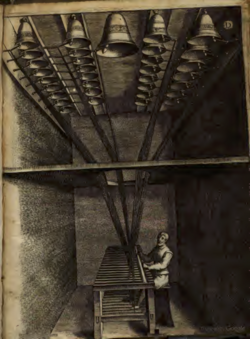
The earliest records of bells being played with some form of primitive keyboard date to the turn of the 16th century. On 30 December 1482, the city of Antwerp appointed a man named Eliseus to play a small set of bells in St. Michael's Abbey, which had been outfitted with a system of "ropes and sticks." In 1510, Jan Van Spiere, a prominent local clockmaker, installed "a keyboard in the tower to chime" the set of 9 bells in the Oudenaarde Town Hall.[38]
Development
The new instrument developed in the favorable conditions in the Low Countries during the 16th and 17th centuries. Through ports in Amsterdam and Antwerp, the region gained the financial means and the technological superiority to support bellfounders and their expanding endeavors.[39] Moreover, the political situation under Margaret of Austria and Emperor Charles V brought relative wealth and power to cities. Carillons quickly became a fashionable symbols of civic pride. Cities and towns competed against one another to possess the most imposing instruments comprised of highest quality and largest bells. Often, cities were not satisfied unless they boasted several carillons, and even small villages found the resources to purchase one.[40] The demand was met by a successful industry of bellfounding families, notably the Waghevens and Vanden Gheyns.[41] Together, they produced over 50 carillons during the 16th and early 17th centuries.[42] By 1600, the primitive carillon had become an established feature of the region.[42]
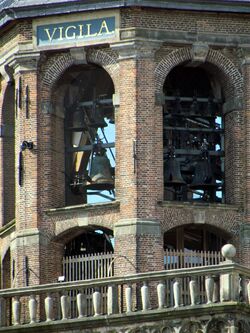
A critical development for the modern carillon occurred in the 17th century, which involved a partnership between Pieter and François Hemony and Jacob van Eyck. The Hemony brothers were prominent bellfounders known for their precise tuning technique. Van Eyck was a renowned blind carillonneur of Utrecht who was commissioned by several Dutch cities to maintain and make improvements to their clock chimes and carillons. He was particularly interested in the sounds of bells, and in 1633, he developed the ability to isolate and describe a bell's five main partial tones and discovered that a bell's partial tones can be tuned harmoniously with each other by adjusting the bell's thickness.[44] The Hemony brothers were commissioned in 1644 to cast 19 bells for Zutphen's Wijnhuis tower with Van Eyck as their consultant. By tuning the bells with the advice from Van Eyck, they created the first carillon by the modern definition.[45] The quality of the bells were so impressive that Van Eyck recommended casting a full two octaves, or 23 bells. This range has been considered the standard minimum range for carillons ever since.[46] During the next 36 years, the Hemony brothers went on to produce 51 carillons.[47] Carillon culture experienced a peak around this time and until the late-18th century.[31]
Decline
The French Revolution had far-reaching consequences on the Low Countries and the carillon. The Austrian Netherlands were conquered by the French and annexed in 1795; the United Provinces were annexed in 1810. In the second year of the French First Republic, the Committee for Public Safety published instructions for extracting the copper from bells.[48] Carillon owners resisted by petitioning the new governments to declare their instruments as "culturally significant" or by disconnecting the bells and burying them in secret.[49] During this period, there were as many as 110 carillons. About 50 of them were destroyed as a result of war, fire, and destruction. The majority were melted down to produce cannons for the French Revolutionary Wars.[48]
Between 1750 and the end of the 19th century, interest in the carillon greatly declined. An increasing number of households had access to grandfather clocks and pocket watches, which eroded the carillon's monopoly on announcing the time. As a musical instrument, the carillon lagged behind during the wandering, story-like nature of Romantic music. Many carillons were tuned using meantone temperament, which meant they were not suited chromaticism of the newer musical styles.[50] The production of new musical works for the instrument essentially came to a standstill.[51] In fact, the standard of carillon performance had dropped so much that in 1895, the music publisher Schott frères issued Matthias Vanden Gheyn's 11 carillon preludes for piano with a foreword claiming that "no carillonneur of our time knows how to play them on the carillon."[52] In addition, the tuning techniques developed by the Hemony brothers, but not Van Eyck's underlying theory, were forgotten as orders for carillons dwindled. Subsequent carillons were generally inferior to earlier installations.[31]
Revival
In the early 1890s, an English change ringer and canon Arthur Simpson published a set of articles on bell tuning, where he argued that bell founders had been complacent with their poor tuning methods and proposed solutions to the existing problems. John William Taylor, who had been trying to replicate the tuning techniques of the Hemony brothers and the Vanden Gheyns at his foundry, began working with Simpson. In 1904, they founded the first tuned bells in over a century.[53] The reinvention initiated a revival of carillon building.[31]
In Mechelen, Belgium, Jef Denyn was as a major figure in the revival of the carillon as a musical instrument. In 1887, after his father had become completely blind, Denyn took over as the city carillonneur, which was responsible for playing the carillon in the tower of St. Rumbold's Cathedral. From the beginning of his career, Denyn advocated for better playability of the instrument. He further developed the tumbler rack system of transmission cables that his father had begun installing on the cathedral carillon, which allowed the player to have better control over dynamic variations, fast musical passages and tremolos.[54] Tremolos offered a solution to a Romantic-era limitation of the carillon: its inability to expressively reproduce sustained notes.
With his improving skills as a carillonneur and the upgraded cathedral carillon, Denyn's performances began attracting crowds of listeners. He established regular Monday night concerts at the suggestion of the city council.[56] On August 1, 1892, Denyn hosted the first carillon concert in history.[57] This step brought the carillon, from its role of providing background music to the public, to the foreground. From this point forward, the instrument garnered a reputation as a concert instrument.[58]
International attention
As a result of his concerts, Denyn made acquaintance with William Gorham Rice, an American state and federal government official from Albany, New York. Rice, having traveled to The Hague and been exposed to the carillon, was regularly touring the region to interview carillonneurs for his book. After Denyn's 18 August 1913 evening concert, he and Rice exchanged ideas about the societal power of the carillon and its educational value.[59] Rice's book Carillons of Belgium and Holland was published in December 1914 and reprinted three times. The book painted an idealized picture that resonated with the American public, particularly in light of the rape of Belgium.[60] Its success motivated Rice to publish two more in 1915 and 1925.[61] Rice became an authority on carillons in the United States; in addition to his books, he gave 35 lectures in several cities, published articles in magazines, spoke on radio programs, and presented exhibition material on the subject between 1912 and 1922.[62] In 1922, Rice garnered financial support from Herbert Hoover and John D. Rockefeller Jr. to help establish a carillon school in Mechelen with Denyn as its first director. It was later named the Royal Carillon School "Jef Denyn".[63]
The destruction of carillons during World War I and World War II were seen as an annihilation of a unique democratic music instrument was highly publicized among the allies of Belgium and the Netherlands. In the second war, British investigators claimed that Nazi Germany seized two thirds of all bells in Belgium and every last bell in the Netherlands. Between 1938 and 1945, 175,000 bells were stolen and stored in "bell cemeteries" (German: Glockenfriedhöfe). Some 150,000 were sent to foundries and melted down for their copper.[64] Following the war, Percival Price, Canada's first Dominion Carillonneur and one of the first professional carillonneurs in North America,[65] was dispatched to help investigate and repatriate as many surviving bells as possible. Price capitalized on the unique opportunity to publish a study on the ideal tonal qualities of Europe's bells.[64]
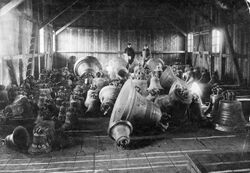
In 1999, UNESCO designated 32 bell towers in Belgium as a World Heritage Site, in recognition of their architectural diversity and significance. The list was expanded in 2005 to include 23 located in France as well as the tower of Gembloux, Belgium.[66] In 2014, UNESCO recognized the carillon cultures of the Netherlands and Belgium as intangible cultural heritages, stating, "UNESCO recognizes the creativity of carillonneurs and others who ensure that this cultural form remains relevant to today's local societies."[67][68]
In 2008, the carillon was featured in the film Welcome to the Sticks, which saw success in the box office as the highest grossing French film ever released in France (As of 2021)[69]
Usage and repertoire
Music
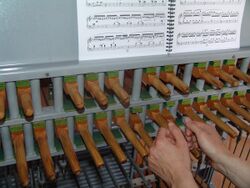
The carillon repertoire skews heavily toward newer works in stark contrast to that of its relative the organ's. Only about 15 collections of carillon music written before 1900 are known to still exist.[70] As with the early history of the pipe organ, performers relied heavily on improvisations. Archival evidence shows that many early carillonneurs were required to instruct others, especially as they neared retirement.[71] In the late Renaissance and early Baroque eras, keyboard music was not written for one instrument or another, but rather was written to be played on any keyboard instrument. For this reason, much of the carillon's repertoire in its early history was likely the same as that of the harpsichord, organ, and piano. One of the few surviving examples of evidence is the carillon book of Joannes de Gruytters, dated 1746.[72] The music is clearly arranged for rather than composed for performance on the carillon and could easily be played on other keyboard instruments. Baroque keyboard music is well suited for carillon transcription, particularly the works of Vivaldi, Couperin, Corelli, Bach, Mozart, and Handel.[31]
The earliest known original compositions specifically for the carillon and not simply any keyboard are the famous eleven preludes of Matthias Vanden Gheyn. The structure of his works suggest that he had been playing non-specific keyboard music on the carillon for many years and that he wanted to play music that is idiomatic to the instrument.[51] Technically challenging, his preludes have been standard repertoire among carillonneurs since the early 1900s.[73]
Jef Denyn made many public statements about what music should be performed on the carillon, and he persuaded several composers of the time to write for it. Among those composers were his students Staf Nees, Léon Henry, and Jef Rottiers. Others were composers of other media, such as Jef van Hoof.[74] The carillon school began publishing carillon music in 1925.[75] The school was the early proponent of the "Mechelen" or "Flemish" style of carillon music, which consists of virtuosic flourishes, fast passages, tremolos, and other Baroque and Romantic elements.[76]
A distinct North American style of carillon music emerged in the 1950s and 1960s at the University of Kansas. Ronald Barnes, the university's carillonneur, encouraged his peers to compose for the carillon and produced many of his own compositions.[77] Barnes' campaign was most successful with Roy Hamlin Johnson, a piano professor who introduced a whole category of music exclusively native to the carillon featuring the octatonic scale.[78] Many of Johnson's works are acknowledged as masterpieces.[79] Barnes produced 56 original compositions and hundreds of arrangements to expand the available repertoire. Other major 20th-century contributors were Albert Gerken, Gary C. White, Johan Franco, and John Pozdro.[80] The new American style developed into the antithesis of the Mechelen style: instead of exciting, tremolo-filled performances that demonstrate the showmanship of the carillonneur, it features slow passages, sparse harmonies, and impressionist themes to draw the listener's attention to the natural sound of the bells.[81]
Carillon music was first published in North America in 1934. G. Schirmer Inc. published the compositions of Curtis Institute of Music students Samuel Barber, Gian Carlo Menotti, and Nino Rota as part of the institute's short-lived publishing series.[82] Music for the instrument was sporadically published in North America until 1961, when the Guild of Carillonneurs in North America began regularly publishing music.[83]
Organization and education
The World Carillon Federation is the central organization of carillon players and enthusiasts. It was founded in the 1970s as a federation of the preexisting national or regional carillon organizations.[84] (As of 2021) it is comprised of 14 member organizations:[29]
- British Carillon Society
- Brotherhood of Bell Ringers and Carillonists of Catalonia
- Carillon Society of Australia
- Dutch Carillon Association
- Flemish Carillon Association
- German Carillon Association
- Guild of French Carillonneurs
- Guild of Carillonneurs in North America
- Lithuanian Carillonist Guild
- Nordic Society for Campanology and Carillons
- Polish Carillon Association
- Russian Carillon Foundation
- Swiss Carillonneurs and Campanologists Guild
- Walloon Campanaire Association
The federation organizes an international carillon congress in one of the home countries of the member organizations every three years. The congresses host lectures, workshops, and committee meetings about the topics related to the carillon, for example: news, tutorials and demos, and research developments.[85] Most member organizations publish periodicals to update its members on the current state of carillon culture in their respective regions.[85]
Training to perform on a carillon can be obtained at several institutions, though the Royal Carillon School "Jef Denyn" remains the most sought-after educational program for the carillon in the world.[85] The LUCA School of Arts in Leuven, Belgium offers a master's program in the carillon, and the Utrecht School of the Arts in Amersfoort, Netherlands has a dedicated school.[86] There are schools elsewhere in the United Kingdom,[87] France, and Denmark.[88]
The Guild of Carillonneurs in North America organizes carillon examinations during its annual congresses. Those who pass are certified as carillonneur-members of the guild. It also partners with the North American Carillon School, founded in 2012 as an affiliate of the Royal Carillon School "Jef Denyn."[85][89] Several American universities offer a carillon program within their curriculum.[85] The University of California, Berkeley,[90] the University of California, Santa Barbara,[91] the University of Michigan,[92] the University of Florida,[93] and the University of Denver[94] offer complete courses of study. Clemson University,[95] the University of Kansas,[96] Iowa State University,[97] Marquette University,[98] and Indiana University[99] offer limited credit for carillon performance. Employed carillonneurs at several universities and also those not employed at university-owned carillons offer private lessons.[89] Universities that possess a carillon but do not offer course credit often have a club or student-run education program, such as the Yale Guild of Carillonneurs, which manages performances on the Yale Memorial Carillon.[100]
Distribution
There are several institutions which register and count carillons worldwide. Some registries specialize in counting specific types of carillons. For example, the War Memorial and Peace Carillons registry counts instruments which serve as war memorials or were built in the name of promoting world peace.[101] The World Carillon Federation counts only "traditional carillons," i.e. carillons which are played via a baton keyboard and without computerized or electronic mechanisms.[102] TowerBells counts both traditional and non-traditional carillons, among other bell instruments, and publishes maps, technical specifications, and summary statistics.[103]
According to TowerBells and the World Carillon Federation, there are about 700 existing traditional carillons. At least three can be found on every content except Antarctica; however, of the countries in which traditional carillons can be found, only 6 have more than 20. The "great carillon" countries[104]—the Netherlands, Belgium, and the United States —account for two-thirds of the world total. Over 90 percent are located in either Western Europe (mainly the Low Countries) or North America. In North America, about 80 percent of carillons are owned by religious or educational institutions,[105] while in Europe, nearly all carillons are municipally owned.[106] Almost all extant traditional carillons were constructed in the last 100 years; only some fifty historical carillons from the 18th century or earlier still exist.[26] According to TowerBells, there are an additional 483 non-traditional carillons, which are mainly located in the United States and Western Europe.
| Country | Traditional carillons | Non-traditional carillons counted by TB[107] | |
|---|---|---|---|
| Counted by WCF[102] | Counted by TB[108] | ||
| Algeria | 0 | 0 | 1 |
| Argentina | 0 | 0 | 5 |
| Australia | 2 | 3 | 3 |
| Austria | 2 | 2 | 5 |
| Belgium | 93 | 92 | 24 |
| Bermuda | 0 | 1 | 0 |
| Bosnia and Herzegovina | 0 | 1 | 0 |
| Brazil | 2 | 3 | 1 |
| Canada | 11 | 11 | 7 |
| Canary Islands (Spain ) | 0 | 0 | 1 |
| Chile | 0 | 0 | 1 |
| China | 0 | 1 | 1 |
| Cuba | 0 | 1 | 0 |
| Curaçao (Netherlands) | 1 | 1 | 3 |
| Czech Republic | 0 | 2 | 1 |
| Denmark | 28 | 29 | 20 |
| Dominican Republic | 0 | 0 | 1 |
| Egypt | 0 | 1 | 1 |
| El Salvador | 0 | 1 | 0 |
| England (United Kingdom ) | 8 | 9 | 8 |
| Estonia | 0 | 0 | 1 |
| Finland | 0 | 0 | 1 |
| France | 73 | 61 | 19 |
| Germany | 48 | 49 | 99 |
| Greece | 0 | 0 | 1 |
| Greenland (Denmark ) | 0 | 0 | 1 |
| Guatemala | 0 | 0 | 1 |
| Honduras | 0 | 1 | 0 |
| Hong Kong (China ) | 0 | 0 | 1 |
| Hungary | 0 | 0 | 2 |
| Iceland | 0 | 0 | 1 |
| Ireland | 1 | 1 | 0 |
| Israel | 1 | 1 | 0 |
| Italy | 0 | 0 | 4 |
| Japan | 3 | 3 | 5 |
| Liberia | 0 | 0 | 1 |
| Lithuania | 3 | 2 | 0 |
| Luxembourg | 1 | 1 | 1 |
| Mexico | 3 | 3 | 6 |
| Mozambique | 0 | 0 | 1 |
| Netherlands | 184 | 189 | 63 |
| New Zealand | 1 | 1 | 1 |
| Nicaragua | 0 | 1 | 0 |
| Northern Ireland (United Kingdom ) |
1 | 1 | 0 |
| Norway | 12 | 11 | 2 |
| Peru | 0 | 0 | 2 |
| Philippines | 1 | 1 | 2 |
| Poland | 2 | 3 | 0 |
| Portugal | 3 | 6 | 2 |
| Puerto Rico (United States ) | 0 | 0 | 2 |
| Réunion (France ) | 0 | 1 | 0 |
| Russia | 2 | 2 | 4 |
| Scotland (United Kingdom ) | 5 | 5 | 1 |
| Serbia | 0 | 0 | 1 |
| Singapore | 0 | 0 | 1 |
| South Africa | 1 | 3 | 3 |
| South Korea | 1 | 1 | 3 |
| Spain | 4 | 5 | 1 |
| Suriname | 0 | 1 | 0 |
| Sweden | 14 | 15 | 13 |
| Switzerland | 5 | 6 | 7 |
| Ukraine | 1 | 1 | 0 |
| United States | 170 | 174 | 144 |
| Uruguay | 0 | 1 | 1 |
| Venezuela | 0 | 1 | 0 |
| Zaire | 0 | 0 | 1 |
| Zimbabwe | 0 | 0 | 1 |
| World | 687 | 709 | 483 |
Traveling carillons
Traveling or mobile carillons are those which are not housed in a tower. Instead, the bells and playing console are installed on a frame that allow it to be transported. These carillons have to be much lighter than their non-mobile counterparts.[109] The idea of a traveling carillon was conceived between 1933 and 1938 by Nora Johnston. She connected a traditional baton keyboard to a system of chime bars and fixed the structure to a portable frame. Johnston traveled twice to the United States to perform in documentary radio programs, orchestral concerts, and commercials.[110] Subsequent constructions by others consisted of actual carillon bells.[111]
According to counts by the World Carillon Federation[112] and TowerBells,[113] there are about 20 existing traveling carillons with only 3 being non-traditional. Many were or are currently owned by bell foundries as a promotional tool. Almost all traveling carillons are headquartered in Western Europe and the United States. Two American traveling carillons are part of the musical group Cast in Bronze, which features the "The Spirit of the Bells" playing the carillon in concert with other instruments or a recording. Cast in Bronze is credited with introducing the carillon to the general public of the United States in its mission to promote and preserve the instrument.[114]
See also
- Belfries of Belgium and France
- Change ringing
- Chime (bell instrument)
- Electronic carillon
- Ring of bells
- Russian Orthodox bell ringing
- Welcome to the Sticks
References
- ↑ "Carillon." Oxford English Dictionary.
- ↑ "Carillon." Online Etymology Dictionary.
- ↑ "Was ist ein Carillon?" (in de). https://glockenspieler.de/was-ist-ein-carillon.
- ↑ Price 1983, p. 222: "The player of this unique keyboard is known in Flemish as a beiaardier and in French as a carillonneur, which last term was also adopted in English after the campaigns of Marlborough brought British troops on to Flemish soil and gave a British march to be chimed from Flemish towers."
- ↑ Barnes 2014, p. 41; Halsted 2012, p. 10
- ↑ Ng & Lewis 2020, p. 1.
- ↑ 7.0 7.1 Lehr 2005, p. 90.
- ↑ Gouwens 2017, p. 3.
- ↑ 9.0 9.1 Lehr 2005, p. 80.
- ↑ Courter, et.al. 2006, p. 2.
- ↑ Courter, et.al. 2006, p. 3; Rombouts 2014, pp. 292–93
- ↑ Courter, et.al. 2006, p. 3.
- ↑ "Carillon Keyboard Standards". https://www.carillon.org/eng/dynamic_frame_eng.htm?https://www.carillon.org/eng/actueel/gdansk_3.htm.
- ↑ 14.0 14.1 14.2 "Playing Mechanism." Guild of Carillonneurs in North America.
- ↑ Lehr 2005, p. 84.
- ↑ 16.0 16.1 Rech, "How the Carillon Works." Essential Vermeer.
- ↑ 17.0 17.1 Rice 1914, p. 23.
- ↑ Lehr 2005, pp. 87–88.
- ↑ Lehr 2005, p. 88.
- ↑ Lehr 2005, p. 83.
- ↑ Lehr 2005, pp. 97–98.
- ↑ Rombouts 2014, p. 45.
- ↑ Price 1983, p. 210.
- ↑ "Carillon Bells." Guild of Carillonneurs in North America.
- ↑ 25.0 25.1 25.2 25.3 25.4 25.5 Brink 2017.
- ↑ 26.0 26.1 26.2 26.3 Rombouts 2014, p. 310.
- ↑ "Carillon". The Riverside Church in the City of New York. https://www.trcnyc.org/music/.
- ↑ The Riverside Church (Report). New York City Landmarks Preservation Commission. 2000-05-16. p. 7. http://s-media.nyc.gov/agencies/lpc/lp/2037.pdf. Retrieved 2021-05-05.
- ↑ 29.0 29.1 29.2 "Organization." World Carillon Federation.
- ↑ 30.0 30.1 "A Musical Instrument." Guild of Carillonneurs in North America.
- ↑ 31.0 31.1 31.2 31.3 31.4 31.5 "Carillon." Encyclopaedia Britannica.
- ↑ Lehr 2005, p. 54.
- ↑ For example:
- Rodriguez, Susan T. (2020-10-09). "Metz Bicentennial Grand Carillon, Indiana University". Architect Magazine. https://www.architectmagazine.com/project-gallery/metz-bicentennial-grand-carillon-indiana-university_o. Retrieved 2021-05-17.
- LaRocca, Aaron (2019-10-21). "Netherlands Carillon to be Restored and Elevated to 'Grand Carillon' Status" (Press release). National Park Service. Retrieved 2021-05-17.
- "Millennium Carillon in Moser Tower & Visitor Center". https://www.napervilleparks.org/facilities/millenniumcarillon.
- Harhen, Nora (2014-11-17). "Wait, the Campanile’s Bells Aren’t Automated?". The Daily Californian. https://www.dailycal.org/2014/11/07/wait-campaniles-bells-arent-automated/.
- ↑ "Carillon". Kirk in the Hills. https://kirkinthehills.org/worship/music/.
- ↑ Lehr 2005, p. 53.
- ↑ Gouwens 2017, p. 123.
- ↑ Rombouts 2014, p. 76.
- ↑ Gouwens 2017, p. 124; Rombouts 2014, pp. 60–61
- ↑ Swager 1993, p. 14.
- ↑ Rombouts 2014, pp. 71–74.
- ↑ Gouwens 2017, p. 124.
- ↑ 42.0 42.1 Swager 1993, p. 12.
- ↑ "NLDVNTSL". http://www.towerbells.org/data/NLDVNTSL.HTM.
- ↑ Price 1983, p. 219; Gouwens 2017, p. 125
- ↑ Swager 1993, pp. 16–20.
- ↑ Gouwens 2017, p. 125.
- ↑ Rombouts 2014, pp. 94–95; Price 1983, p. 219
- ↑ 48.0 48.1 Swager 1993, pp. 39–40.
- ↑ Rombouts 2014, pp. 141–44.
- ↑ Rombouts 2014, pp. 149–50; Swager 1993, pp. 41–42
- ↑ 51.0 51.1 Van Ulft 2020, p. 33.
- ↑ Price 1983, p. 224
- ↑ Rombouts 2014, pp. 173–76.
- ↑ Rombouts 2014, pp. 179–80.
- ↑ Swager 1993, pp. 48–49.
- ↑ Swager 1993, pp. 50–51.
- ↑ Rombouts 2014, p. 181.
- ↑ Swager 1993, p. 51.
- ↑ Rombouts 2014, p. 188.
- ↑ Rombouts 2014, pp. 197–98; Thorne 2018
- ↑ Rombouts 2014, pp. 198.
- ↑ Rombouts 2014, p. 208.
- ↑ Rombouts 2014, p. 208; Price 1983, pp. 227–28; Gouwens 2017, p. 134
- ↑ 64.0 64.1 Thorne 2018.
- ↑ Gouwens 2017, p. 139.
- ↑ "Belfries of Belgium and France". United Nations. https://whc.unesco.org/en/list/943/.
- ↑ "Belgische beiaardcultuur erkend als erfgoed" (in nl). VRT NWS. 2014-11-25. https://www.vrt.be/vrtnws/nl/2014/11/25/belgische_beiaardcultuurerkendalserfgoed-1-2159300/.
- ↑ "Bespelen klokkenspel wordt cultureel erfgoed" (in nl). de Volkskrant. 2014-08-21. http://www.volkskrant.nl/vk/nl/2664/Nieuws/article/detail/3722604/2014/08/21/Bespelen-klokkenspel-wordt-cultureel-erfgoed.dhtml.
- ↑ "Welcome to the Sticks". IMDb. https://www.boxofficemojo.com/release/rl3703866881/rankings/?ref_=bo_rl_tab#tabs.
- ↑ Rombouts 2014, p. 129.
- ↑ Gouwens 2017, p. 127.
- ↑ Van Ulft 2020, p. 32.
- ↑ Rombouts 2014, p. 115.
- ↑ Gouwens 2017, p. 134.
- ↑ Price 1983, p. 230.
- ↑ Van Ulft 2020, pp. 33–34.
- ↑ Rombouts 2014, p. 289.
- ↑ Keldermans & Keldermans 1996, pp. 164.
- ↑ Gouwens 2017, p. 140.
- ↑ Keldermans & Keldermans 1996, pp. 163–65.
- ↑ Rombouts 2014, pp. 290–91.
- ↑ De Turk 1999, p. 53.
- ↑ Gouwens 2017, p. 143.
- ↑ Rombouts 2014, p. 312.
- ↑ 85.0 85.1 85.2 85.3 85.4 Rombouts 2014, p. 313.
- ↑ "Utrecht School of the Arts, Faculty of Music". http://www.hku.nl/web/English/English/Bachelors/BachelorOfMusic/Carillon.htm.
- ↑ "Carillonneur: Trevor Workman". https://www.bournvillecarillon.co.uk/trevor-workman.
- ↑ "Løgum Kloster Kirkemusikskole". Locus Dei. http://www.locus-dei.dk/kms/.
- ↑ 89.0 89.1 "Learn to Play." Guild of Carillonneurs in North America.
- ↑ "Carillon Study". University of California, Berkeley. https://music.berkeley.edu/performance-opportunities/carillon-study/.
- ↑ "Carillon". University of California, Santa Barbara. https://www.music.ucsb.edu/ensembles/carillon.
- ↑ "Carillon Studio". University of Michigan. https://smtd.umich.edu/current-students-3/carillon-studio/.
- ↑ "Carillon Studio". University of Florida. https://arts.ufl.edu/sites/carillon-studio/welcome/.
- ↑ "Carillon Studio". University of Denver. https://liberalarts.du.edu/lamont/academics/carillon-studio.
- ↑ "Carillon". Clemson University. https://www.clemson.edu/caah/departments/performing-arts/students/Music/Keyboard/carillon.html.
- ↑ "Carillon Recitals". University of Kansas. https://music.ku.edu/organ/carillon/recitals.
- ↑ "Edgar W. and Margaret MacDonald Stanton Memorial Carillon". Iowa State University. https://www.music.iastate.edu/carillon.
- ↑ "Carillon Discovery Course". Marquette University. https://www.marquette.edu/communication/carillon-discovery-course.php.
- ↑ "Applied Carillon Study at the Jacobs School of Music". Indiana University. https://blogs.iu.edu/jsomorgan/applied-carillon-study/.
- ↑ "About the Guild". http://yalecarillon.org/about-guild.
- ↑ "World map of peace carillons". https://www.peacecarillons.org/world-map-of-peace-carillons/.
- ↑ 102.0 102.1 "Carillons". http://www.carillon.org/eng/fs_carillon.htm.
- ↑ "More About Carillons and Other Tower Bell Instruments". http://www.towerbells.org/data/Data_Top.html.
- ↑ Rombouts 2014, p. 309.
- ↑ "North American traditional carillons by type of institution". http://www.towerbells.org/data/IXNATRinstype.html.
- ↑ Lee, Roy (April 2021). "From the President's Corner". Carillon News (Guild of Carillonneurs in North America) (105): 3. https://www.gcna.org/resources/Documents/Carillon-News-2021-04.pdf. Retrieved 2021-05-05.
- ↑ "Indexes to Non-traditional Carillons Around the World." TowerBells.org.
- ↑ "Indexes to Traditional Carillons Around the World." TowerBells.org.
- ↑ Widmann 2014, p. 12.
- ↑ Rombouts 2014, pp. 245–46.
- ↑ Widmann 2014, pp. 15–19.
- ↑ "Traveling Carillons". http://www.carillon.org/eng/fs_reizende.htm.
- ↑ "Traveling Carillons and Chimes Worldwide". http://www.towerbells.org/data/IXtraveling.html.
- ↑ Rombouts 2014, p. 316.
Bibliography
- Gouwens, John (2017). Playing the Carillon: An Introductory Method (5 ed.). Guild of Carillonneurs in North America. OCLC 765849175.
- Carillon: The Evolution of a Concert Instrument in North America. Springfield Park District. 1996. ISBN 0-9652252-0-8. https://openlibrary.org/books/OL1024319M/Carillon.
- Lehr, André (2005) (in nl). Campanology Textbook: The Musical and Technical Aspect of Swinging Bells and Carillons. Guild of Carillonneurs in North America. OCLC 154672090.
- Price, Percival (1983). Bells and Man. Oxford University Press. ISBN 978-0-19-318103-8.
- Rice, William Gorham (1914). Carillons of Belgium and Holland: Tower Music in the Low Countries. John Lane Company.
- Rombouts, Luc (2014). Singing Bronze: A History of Carillon Music. Leuven University Press. ISBN 978-90-5867-956-7. https://books.google.com/books?id=jQ-RCAAAQBAJ&pg=PA111.
- Swager, Brian (1993). A History of the Carillon: Its Origins, Development, and Evolution as a Musical Instrument (DMus). Indiana University. OCLC 53120808.
- Barnes, Ronald (1979-03-29). "Carillonist, not Carillonneur" (PDF). The Bulletin (Guild of Carillonneurs in North America) 63 (1): 41–42. 2014. https://www.gcna.org/bulletin. Retrieved 2021-04-05.
- Brink, Joey (2017-12-19). "Composing for Carillon". NewMusicBox. https://nmbx.newmusicusa.org/composing-for-carillon/. Retrieved 2021-04-13.
- De Turk, William (1999). "Barber, Menotti, Rota: Carillon Composers in Residence" (PDF). The Bulletin (Guild of Carillonneurs in North America) 48 (1): 53–65. https://www.gcna.org/bulletin. Retrieved 2021-04-05.
- Halsted, Margo (November 2012). "What's in a Name?" (PDF). Carillon News (Guild of Carillonneurs in North America) (88): 10. https://www.gcna.org/resources/Documents/Carillon-News-2012-11.pdf. Retrieved 2021-04-13.
- Thorne, Stephen J. (2018-11-21). "The Seizing of Europe's Bells". Legion. https://legionmagazine.com/en/2018/11/the-seizing-of-europes-bells/. Retrieved 2021-04-14.
- Van Ulft, Carlo (2020). "Carillon Music: An Evolution" (PDF). The Bulletin (Guild of Carillonneurs in North America) 69 (1): 32–36. https://www.gcna.org/bulletin. Retrieved 2021-04-05.
- Widmann, John (2014). "World Carillon Federation: Mobile Carillons" (PDF). The Bulletin (Guild of Carillonneurs in North America) 63 (2): 12–19. https://www.gcna.org/bulletin. Retrieved 2021-04-16.
- Courter, John; Hurd, Timothy; Janssens, Liesbeth; Macoska, Patrick; Oldenbeuving, Gert; van Wely, Bob (2006). Consensus on technical norms for a world standard carillon keyboard WCF Keyboard 2006 (PDF). World Carillon Federation. http://www.carillon.org/pdf/Technical_Norms.pdf. Retrieved 2021-02-16.
- Ng, Tiffany; Lewis, Emmet (2020-04-30). "International Bibliography of Carillon Music by Women, Transgender, and Nonbinary Composers". University of Michigan Library. p. 1. http://hdl.handle.net/2027.42/153530.
- Rech, Adelheid. "How the Carillon Works". Essential Vermeer 3.0. http://www.essentialvermeer.com/music/carillon/carillon_b.html.
- "Carillon". Encyclopaedia Britannica. https://www.britannica.com/art/carillon. Retrieved 2021-04-13.
- carillon (3rd ed.), Oxford University Press, September 2005, http://oed.com/search?searchType=dictionary&q=carillon, retrieved 2021-02-16 (Subscription or UK public library membership required.)
- "Carillon". https://www.etymonline.com/word/carillon.
- "Carillon Bells". https://www.gcna.org/carillon-bells.
- "Indexes to Non-traditional Carillons Around the World". http://www.towerbells.org/data/NT_type_ixs.html.
- "Indexes to Traditional Carillons Around the World". http://www.towerbells.org/data/TR_type_ixs.html.
- "Learn to Play". https://www.gcna.org/carillon-education.
- "A Musical Instrument". https://www.gcna.org/carillon-instrument.
- "Playing Mechanism". https://www.gcna.org/playing-mechanism.
- "Organization". http://www.carillon.org/eng/fs_orga.htm.
Books
Magazines and journals
Internet
External links
| Wikisource has the text of the 1911 Encyclopædia Britannica article Carillon. |
- World Carillon Federation
- English-speaking, regional carillon organizations
- Short educational video about the carillon from the World Carillon Federation
- Short video tutorial on composing for the carillon
- Towerbells.org, a database of carillons, chimes, zvons, and great bells
- Carillon History, by Adelheid Rech on essentialvermeer.com
- Museum Klok en Peel (Carillon Museum in the Netherlands)
